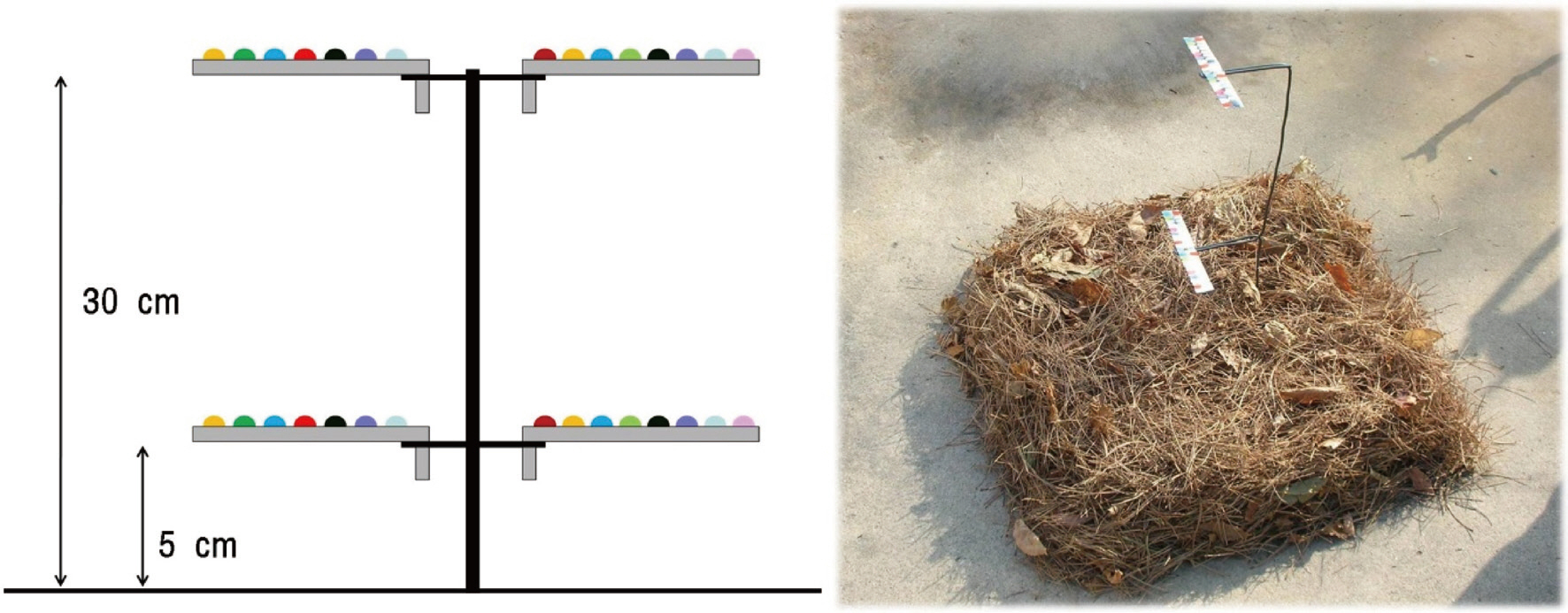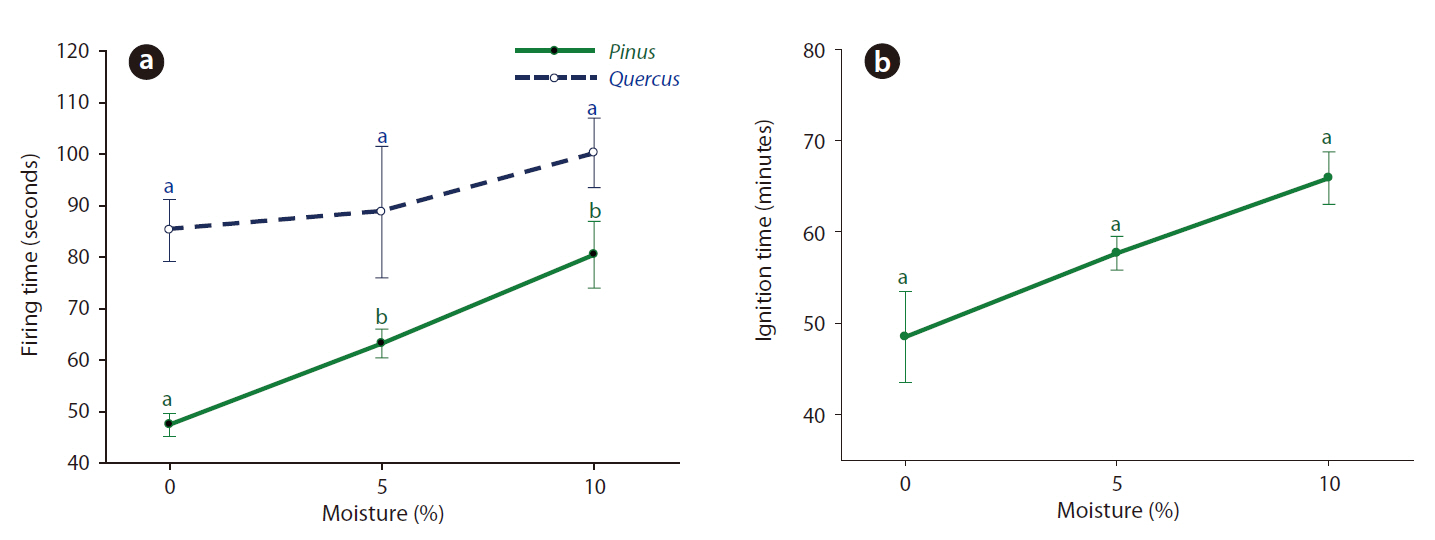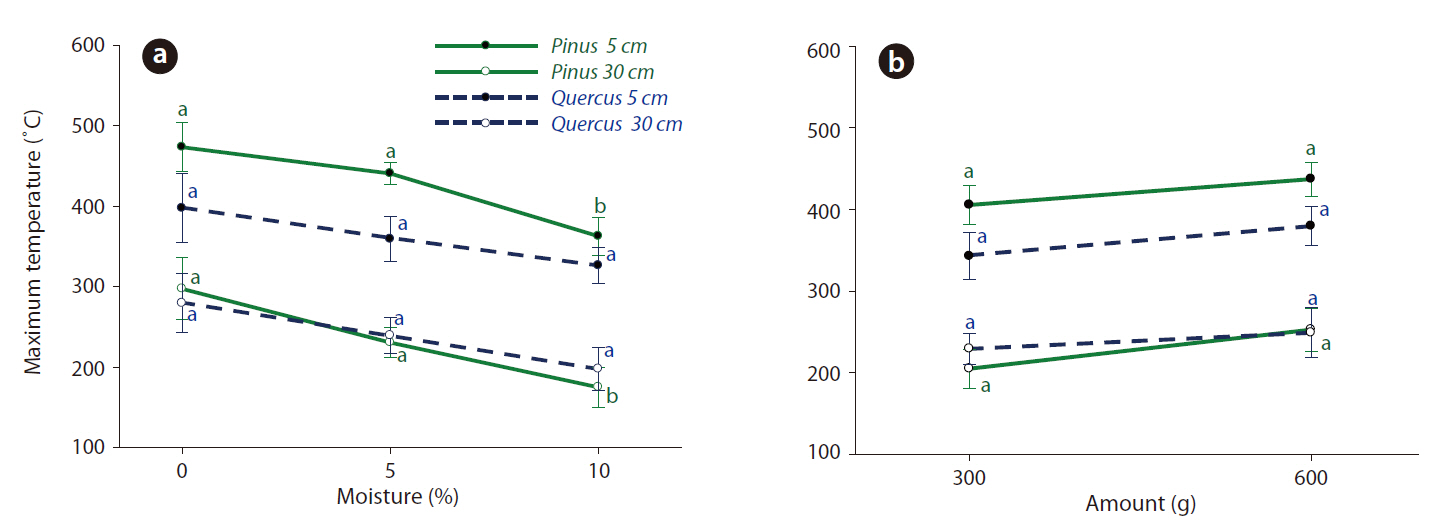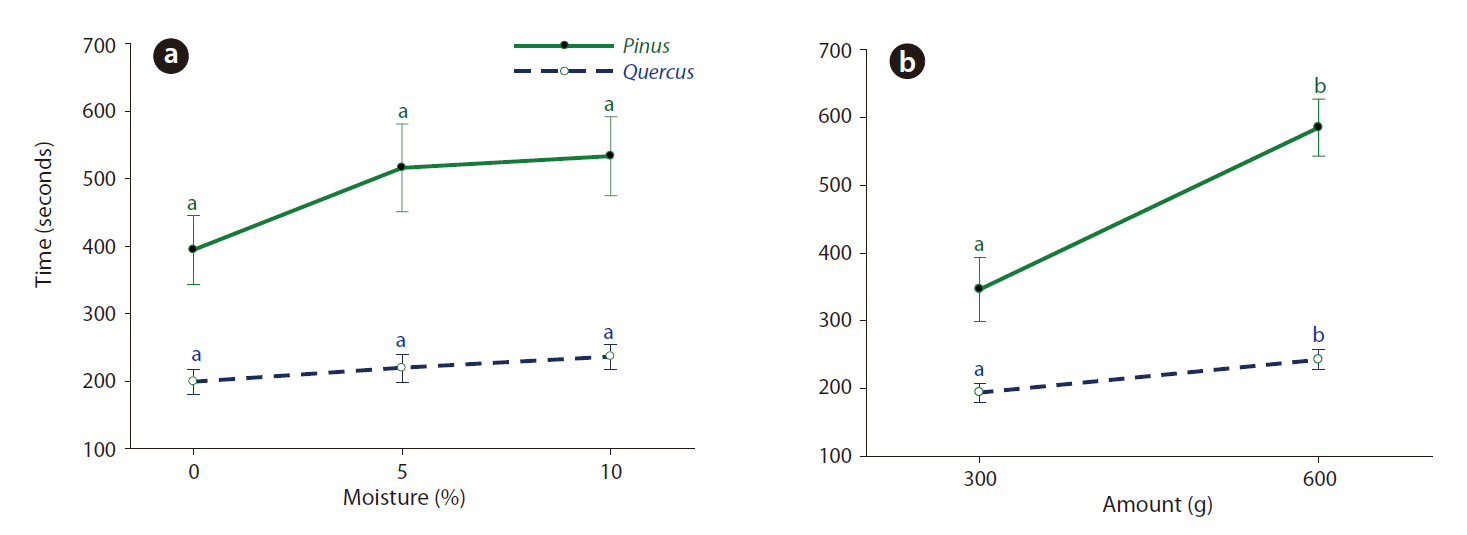



Fires require three factors: fuel, oxygen, and heat (Chandler et al. 1983). Litter, branches, and woody debris are the main fuels implicated in forest fires. In particular,fine fuels such as dried fallen leaves and small branches are regarded as an important factor in the ignition stage (Chandler et al. 1983, Haessler 1989). Once ignited, forest fires move into the spread stage, evidencing a variety of behaviors and intensities depending on the amount of fuel, as well as meteorological or geographical factors (Burgan and Rothermel 1984).
Lee et al. (2005) analyzed forest fire records across the country, and concluded that the initial ignition of forest fires most frequently occurs in coniferous forests (69%), followed by mixed forests (17%) and broadleaf forests(14%), respectively. In this regard, three possibilities have been raised as to why forest fires occur primarily in coniferous forests. First, coniferous forests are characterized by a wide spread, and thus they are very likely to be exposed to people, resulting in a higher possibility of mancaused fires. Second, coniferous trees exist principally at lower elevations near villages or memorial parks, which are easily accessed by humans. Finally, the ignition characteristics of coniferous trees in Korea are responsible to their vulnerability of fire.
It has been reported previously that 42% of domestic forests are coniferous forests, while 26% are broadleaf forests. In the East Coast regions (Goseong, Yangyang, Sokcho, Gangneung, Donghae, and Samcheok) of Gangwon province, where large forest fires most frequently occur, the forest composition is as follows: 38% coniferous, 29% broadleaf and other forests (Korea Forest Service 2009). Coniferous forests cover a wider area than broadleaf forests. However, the ratio of forest fires in coniferous forests is 69%, which is far higher than their proportions relative to other forest types; this cannot be sufficiently explained for the first reason listed above, although it is true that more coniferous forests are distributed throughout regions of lower elevation. The pre-fire vegetation of the East Coast fires region in 2000 was characterized by a relatively high frequency of Pinus densiflora forests, the most dominant forest type among coniferous forests, at lower elevations (Choung et al. 2004). This may, to some degree, be related to that region’s general susceptibility to fire. Clearly, coniferous trees are more likely to encounter heat sources; however, if the fuel cannot be ignited, no fire can start. Thus, greater access to forests by humans is not, in and of itself, a satisfying explanation for the increased vulnerability of coniferous forests to fire.
Therefore, the frequent occurrences of fire in coniferous forests are assumedly attributable to the ignition characteristics of coniferous trees at the ignition stage. P. densiflora harbors a variety of volatile substances, such as resins and terpene, in its timber, cambium, leaves, and branches (Song and Kim 1994). Additionally, its organs contain a large caloric content (Park et al. 2007) which potentially increase firing possibility and allow for prolonged combustion.
In Korea, most fires have been identified as man-caused fires. Forty nine percent of fires are reported by people visiting the graves of family members in mountains or memorial parks which are commonly located in lowland mountainous regions. Thus far, 10% of fires were identified as being directly induced by cigarettes. However, the actual percentile is assumed to be substantially higher than reported. Kim et al. (1994) demonstrated that the coniferous species,
The principal objective of this study was to prove that the ignition characteristics of
Fallen leaves were employed as a fine fuel source, as it evidences higher combustibility and can be readily ignited. In our experiment, fallen leaves of
Assuming that a cigarette is a primary heat source in forest fires, we conducted firing and ignition experiments with fallen leaves with differing moisture contents. The moisture contents were adjusted by spraying water evenly onto 20 g of dried leaves at 0%, 5%, and 10% (v/w) in plastic bags. The plastic bags were kept tight and were shaken until the combustion experiments began the next day. The moisture contents ratios were established on the basis of the moisture contents of fine fuels in
spring seasons in the field, as demonstrated previously by Seo (2010). Firing and burning time were measured by the insertion of a cigarette 1 cm into a 10 cm × 10 cm cluster of leaves. We repeated the same test five times for each of the moisture contents. These experiments were conducted in an open area on June 14, 2009. Wind speed was in the range of 0-1.2 m/s, and the air temperature and relative humidity were 21.5-23.9°C and 54.6-63.1%, respectively.
In the second experiment, we burned leaves with differing moisture contents and quantities of fuel, and then determined the maximum burning temperature and burning time. The moisture contents were adjusted to 0%, 5%, and 10% in the same fashion as was established for the above test. Both 300 g and 600 g of the 50 cm × 50 cm cluster of leaves (1,200 g and 2,400 g per m2, respectively) were set on the basis of the amount of leaves in a natural setting, according to Seo (2010), on the ground. A torch was then used to set fire to the leaves. To measure the temperature of the flame, we designed a thermocolor pyrometer modified from the research of Graham and McCarthy (2006). The thermocolor pyrometer consists of 15 different Tempilaq° G liquid paints on aluminum tags with various melting points (79, 107, 135, 163, 191, 218, 246, 274, 316, 371, 427, 482, 538, 593, and 649°C). Two of the thermocolor pyrometers were set at heights of 5 cm and 30 cm on the right and left (Fig. 1). The maximum burning temperature was determined by checking the melted paint on the right and left aluminum tags. We measured the burning time when the leaves had burnt completely. The second experiments were repeated four times in the open area at two different days, April 18 and May 30, 2009. On April 18, the wind speed was in a range of 1.9-2.8 m/s, and the air temperature and relative humidity were 21.7-25.5°C and 13.4-21.1%, respectively. On May 30, the wind speed was in a range of 0-1.2 m/s, and the air temperature and relative humidity were 16.4-22.4°C and 33.4-54.4%, respectively. The results from the two different days were averaged.
We used an analysis of variance to assess significant differences between species, moisture contents and fuel loads on firing time, maximum temperature, and burning time. Mean differences were analyzed via Bonferroni’s post hoc test. Multiple regression analysis was employed to determine the relative effects of burning temperature and time. SYSTAT ver. 10 (SPSS Inc., Chicago, IL, USA) software was employed to process the results of the analyses.
>
Firing and ignition by cigarette
Seo (2010) monitored the varying moisture contents of fine fuel from
Such results support the hypothesis that cigarette butts thrown in the forest during the spring season can cause fine fuels to catch fire, and may possibly ignite forest fires in
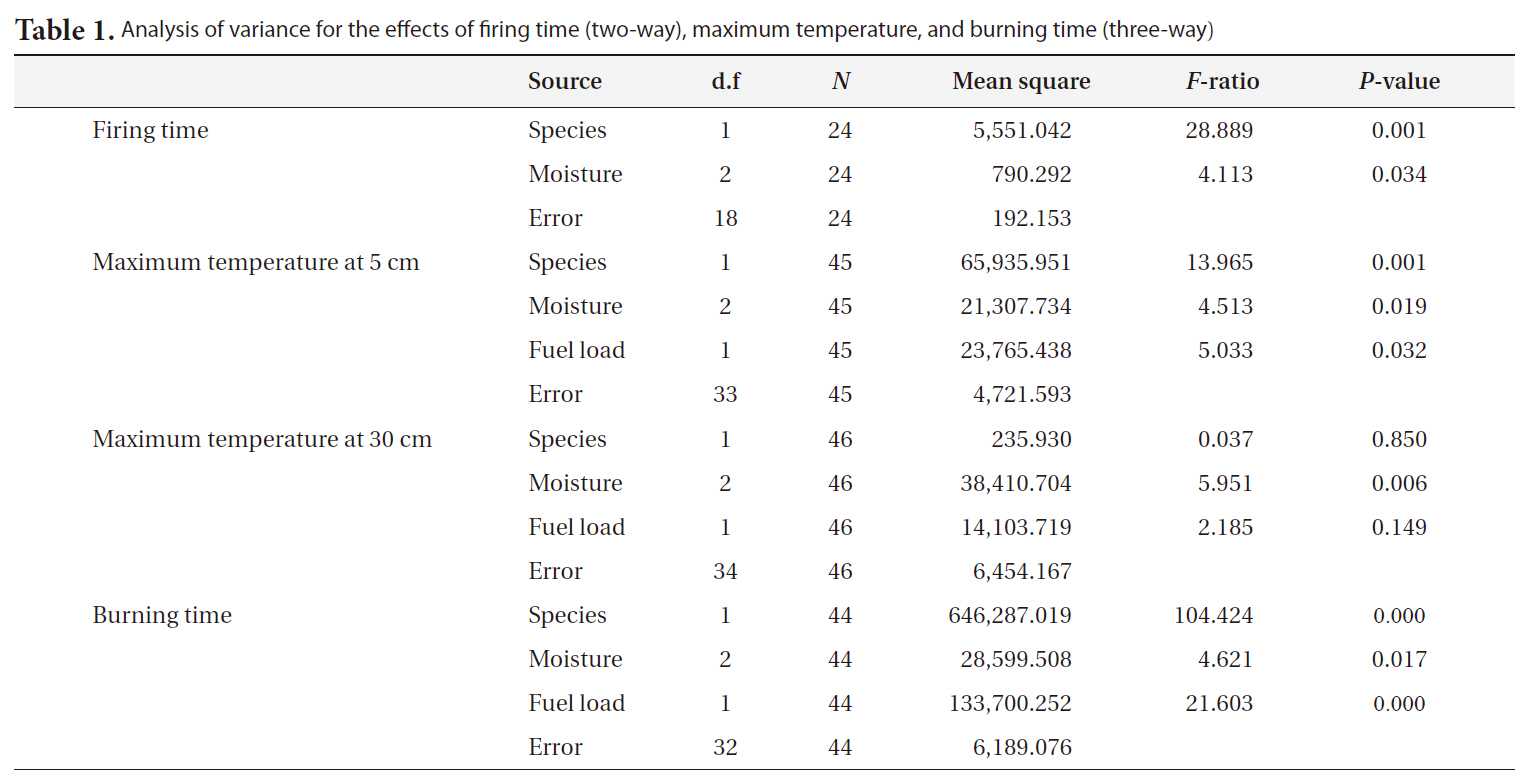
Analysis of variance for the effects of firing time (two-way) maximum temperature and burning time (three-way)
>
Maximum burning temperature and burning time
We burned the leaves of
Both species appeared to have the highest burning temperature with the lowest moisture contents, and the burning temperature increased as the quantity of fuel increased as well.
and an average of 363°C at 10% (apparently the lowest temperature in the tested ranges). When the quantity of Pinus leaves was 600 g at a height of 5 cm, the burning temperature was an average of 437°C, which is approximately 1.1 times the average of 405°C measured with a mass of 300 g.
According to the analysis of variance with the maximum burning temperatures between two species for various moisture contents and fuel amounts (Table 1), we noted that the maximum temperature of Pinus at a height of 5 cm was significantly higher than that of
The burning time of
In particular, with increases in the quantity of fuel,
Nevertheless, the fact that forest fires occur less frequently in broadleaf forests such as
As a short-term plan, we recommend that specific areas densely forested with
